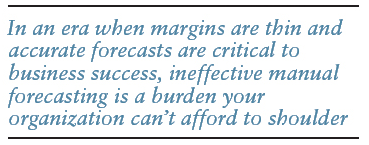A Forecasting Rx for Pharmacy Benefit Managers
Pharmaceutical Executive
Building an effective drug forecasting model today requires a revamped approach.

The easy wins for pharmacy benefit management (PBM) companies are mostly in the rearview mirror. When PBMs first emerged on the healthcare scene, the novelty of their cost-saving proposition was enough to sell their services to insurers and self-insured companies. Today, PBMs face fierce competition, and their core services have essentially become commoditized.
To stay ahead of the curve, PBMs should consider using the same forecasting technologies that have brought important savings to the utility and staffing fields. By more accurately predicting claims, PBMs can gain leverage in seeking volume-based client discounts, streamline their mail-service business, automate the manual processes for determining resource staffing, and make more timely forecasts that will satisfy the "c-suite" and investors.
The limits of current forecasting
Most revenue or supply chain forecasting is centered on the projection of periodic claims and revenues (typically monthly) for each primary client and channel (e.g., mail order or electronic). Forecasts are usually based on historical claim volumes extracted from summarized transaction-level information. In most cases, the main drivers for the forecast reflect anticipated aggregate plan membership, drug demand, drug lifecycle status, and drug processing costs. Claims are forecasted over horizons of one to three years and used as a basis for business planning and client negotiation. Outside data is rarely used.
Forecast models are often heavily dependent on member projections based on anticipated client acquisition, retention, and drug-use reduction activity. This can vary dramatically from year to year and has a certain degree of inherent volatility. For instance, if the client is based in a high-pollen part of the country where a large percent of the population uses a prescription allergy medicine, a delay in a medication either going off patent or over the counter could affect the forecast. That type of forecast can't be done one to three years in advance.
In general, the drug life cycle (reflecting pre-launch, launch, on-patent period, exclusivity, migration to generic, and retirement)

cannot be modeled easily. The transition point from brand to generic is particularly difficult to forecast and can cause a major deviation from expected claims.
It can also be particularly difficult to forecast below the client level. Hidden sources of volatility exist if a PBM can't segment customers or explore regional variation, therapeutic class, or lifecycle point forecasts. All are difficult to do with traditional forecasting techniques.
The trouble with a one-off approach
PBMs often rely on episodic, one-off analysis. A team will do an extensive analysis to, for instance, understand the potential costs associated with a new class of medicine to treat a chronic illness. This approach is helpful in the short term, but problematic in the long term. These projections are designed to make decisions at a single point in time by looking at multiple scenarios based on unplanned deviations from expected conditions. For example, instead of extrapolating projected costs based on analysis of the cost trajectory of another medicine at similar points in its lifecycle, the forecast process should consider exploring the similarity of cost patterns for a wide variety of medicines based on qualitative and quantitative attributes as the basis for a better forecast.
The pharmacy and flu season
One of the biggest forecasting errors PBMs make is not using outside data to inform forecasts. The yearly toll of influenza is a great example of this. The expected demand for antiviral medicine affects the price that the PBM can negotiate, and the counseling on the price the insurer should set with customers. Ideally, you would need to know things like what kind of flu season is predicted, what the client population is like, and what percent of clients get a flu shot.
These are all interesting questions that can be modeled using historical trends, existing health data on the population, claims for flu shots, CDC reports on flu activity, and the effectiveness of the strains in that year's vaccine. A PBM using simple analytics might suggest to a client that the cost of antiviral medication be kept high to encourage members to get the flu shot. But savvy, more nuanced forecasting might indicate such a poor match between the flu shot and the strains circulating that it would be more cost-effective to decrease the cost of antivirals to avoid secondary infections among those that got the flu shot-but still got the flu.
Exploring the benefits of forecasting
There are numerous broader benefits to a sound forecasting process. These include:
» Enhanced profitability: As mentioned, a more accurate claims forecast enhances negotiation leverage. In addition, accurate forecasts reduce the likelihood of penalties due to violations of contractual service level guarantees.
» Supply chain improvement: A sound forecast streamlines the mail-service fulfillment process through better inventory control, resource staffing, and overall customer satisfaction improvement.
» Organizational efficiency: Automating a forecast process enables faster throughput and timely dissemination of forecast information throughout the organization. Complex, time-consuming, custom models are a strain on analytical and IT resources.
» Improved business planning: A unified forecasting process that involves interdepartmental participation, review, and consensus can be tied directly to short- and long-range business planning. Customer behavior, market activity, and the influence of global health trends on claims activity can all be built into the planning and growth models.
Establishing robust forecasting involves working within IT and analytical infrastructure, with key inputs from business users. Forecasting models need the same data that everyone else in the company is working with (assuming it is high-quality). The models must also reflect what the business users need to make critical decisions.
Here are some strategies that help build more robust forecasting models:
» Review interdepartmental marketing and planning strategies. You will want to include expansion and price optimization in forecast models. Calculating the impact of forecast error is critical.
» Segment at a deeper level. Review existing claim data sources for information that could drive lower levels of segmentation, such as looking at demographic patterns, lifecycle patterns, and therapeutic classes. This opens up the potential for a multi-tiered forecast approach.
» Explore potential sources of external information (e.g., IMS scripts, CDC incident rates, macro-economic factors) as augmentation to the core forecast.
» Support time-series forecasting and best-fit modeling. Organize transactional claim data into an analytical data mart to support this more accurate way of building forecasts. Time-series techniques, using multiple explanatory variables, allow organizations to test several types of models and employ the structure that best suits the specific data stream.
» Automate the core forecast process. As data is updated, the models should be able to leverage the expanded history with minimal intervention. Model accuracy from period to period could be explored within this context.
» Allow for flexibility in the forecast approach. The ability to implement a waterfall forecasting approach should be available, for example, to forecast expected channel migration activity for certain clients and use that forecast as an input to the claims forecast. Additionally, cost-per-claim forecasting could be a separate activity, with results being applied to claims forecasts when producing revenue projections.
» Add scenario analysis. Unlike one-off analysis, scenario analysis is ongoing forecasting using aggressive and conservative models, expected expansion or contraction, and modeling the likelihood of disruptive events (an unforeseen off-patent date, for example). These scenarios can be stored and maintained as needed. This event repository can be reviewed across departments. This would include assignment of potential significance levels on each previous (and planned) event, as well as the likelihood of occurrence.
» Share forecasts across the organization. Forecasters should control the development of the forecast, but they need to be displayed across the organization so that they are used.
Building a robust forecasting organization does not require a team of programmers. A small utility cooperative was able to lower its rate four times in one year by using a forecasting solution that a very small team could work with. Forecasting can be added to the analytics process in a phased manner, with short, quick goals to test the effectiveness. In an era when margins are thin and accurate forecasts are critical to business success, ineffective manual forecasting is a burden your organization can't afford to shoulder.
Peter Dillman
is Advisory Analytical Consultant, SAS Institute. He can be reached at peter.dillman@sas.com.

Addressing Disparities in Psoriasis Trials: Takeda's Strategies for Inclusivity in Clinical Research
April 14th 2025LaShell Robinson, Head of Global Feasibility and Trial Equity at Takeda, speaks about the company's strategies to engage patients in underrepresented populations in its phase III psoriasis trials.
Beyond the Prescription: Pharma's Role in Digital Health Conversations
April 1st 2025Join us for an insightful conversation with Jennifer Harakal, Head of Regulatory Affairs at Canopy Life Sciences, as we unpack the evolving intersection of social media and healthcare decisions. Discover how pharmaceutical companies can navigate regulatory challenges while meaningfully engaging with consumers in digital spaces. Jennifer shares expert strategies for responsible marketing, working with influencers, and creating educational content that bridges the gap between patients and healthcare providers. A must-listen for pharma marketers looking to build trust and compliance in today's social media landscape.
Pfizer, GSK Gain ACIP Recommendations for RSV and Meningococcal Vaccines
April 18th 2025The Centers for Disease Control and Prevention’s Advisory Committee on Immunization Practices voted to expand access to Pfizer’s respiratory syncytial virus vaccine Abrysvo for high-risk adults in their 50s and voted in favor of GSK’s meningococcal vaccine, Penmenvy, for streamlined adolescent protection.